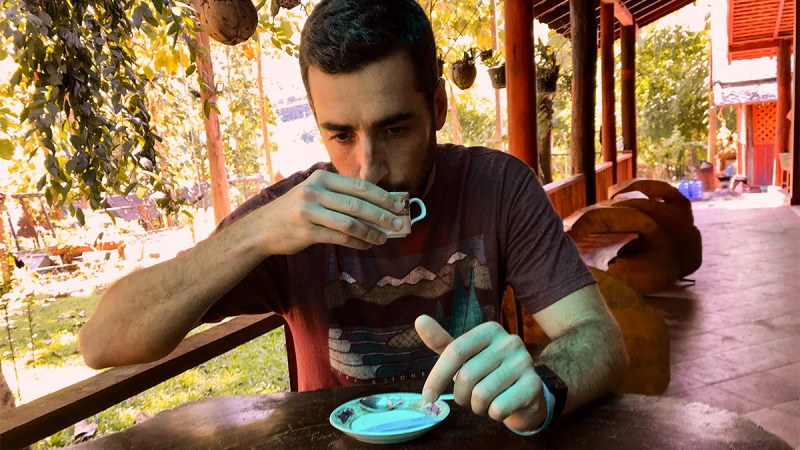If you’ve been lucky enough to try Kopi Luwak, then you’ve already enjoyed some level of personal growth at the hand of travel. For those who haven’t had the chance to indulge in this treat, worry not — there maybe some value in the crap to come.
Kopi Luwak literally translates to “coffee” from a “civet.” In case that isn’t direct enough: It’s coffee collected from, well, civet crap. Civets — which look like an equal mix of weasel and house cat — enjoy eating the fruit from coffee plants. To keep a long story short, the coffee cherry makes its way through the civet and exits as a green coffee bean. The bean is then collected, aged for two-plus years, roasted, brewed, and, finally, enjoyed by a second digestive tract. Proprietors of Kopi Luwak will tell you that this coffee bean is unique for two reasons: 1) It is believed the civet chooses the highest quality coffee beans from the bush and 2) the digestive enzymes break down the coffee’s acidity.

To share from the first-hand experience of this author, the following is my review:
“The coffee was served no different than any other drip coffee. It was strong and black. The flavor was bold and had a good depth to it but the finishing taste was unexpected. A strong cup of coffee usually ends with an equally strong acidic note, which Kopi Luwak did not have. Outside of that quality, Kopi Luwak and other solid coffees don’t differ much.”
Other than spending $20 bucks for a unique experience and a decent cup of coffee in Laos, what value can we find in Kopi Luwak? If you’ll oblige me, this is where I’d like to add some more personal experience to round out the story.
Work brought me to Southeast Asia in November for a company summit that included a four-day day bike tour with 400 coworkers. If that wasn’t crazy enough, it just so happened to coincide with my “agree to disagree” discussions with management about value, a harsh realization that a woman I thought cared about me didn’t, and, of course, Typhoon Damrey. If you can imagine biking the pseudo-mandatory, partially flooded 50-plus miles a day in a typhoon with 400 enthusiastic coworkers around — including she-who-will-not-be-named and the entire management team — then you might start to smell the crap that I was neck deep in.

So what’s the point of all of this? Coffee, crap, minor tragedies? Perhaps we could benefit to update the vocabulary from an old adage: “When life gives you crap, use it as fertilizer for your next move.” Sometimes it seems like everything you worked for is just a big ‘ole pile of crap. Because life has to move forward, as all things always must do, a person can do one of two things with that crap: 1) Stick it somewhere in that weird dark part of your brain with all the other unpleasant things, or 2) see the value in it and use it. In the past I was more of an option No. 1 kind of guy. This time, though, I chose No. 2.
It’s been almost two months since I left Southeast Asia and I feel physically and mentally healthier than I’ve ever felt. I cut my travels short to focus on my pile of crap and what I could make it do for me. Here’s what I did with it:
- The crap: I continued to talk with my managers and asked them to describe what a future at that company might look like for me. The picture isn’t exactly what I’d hoped for. The growth: I now have a clear understanding of my options and am ready to make serious decisions about my future. It’s up to me to actively adjust my expectations with my current employer or to find a new opportunity that paints a brighter future.
Hendrik Broekelschen/The Manual Image used with permission by copyright holder - The crap: The girl. The growth: Instead of avoiding the issue, we talked it out. After hearing her interpretation of the situation, I’m thankful that things didn’t work out. We define love differently and if it didn’t hurt then — it surely would have later. In this case, I moved past someone who kept things in the dark to look towards someone who celebrates the refulgent night sky.
- The crap: The big picture … I’ve been traveling for the last five years and realized it might be time to re-evaluate that lifestyle. The growth: I’d like more stability. Even if I choose to continue traveling for part of the year, I want some roots in a community that I love. That realization pushed me to start the process of purchasing a home in Portland, Oregon.
To revisit the title of this piece, civet crap, heartache, and progress aren’t all that different. All things have a potential that can be leveraged for growth if approached appropriately. Shoot, if people can get excited to pay $20 to drink a cup of civet excrement, then perhaps we can all find some value in our own crap. Let’s say it’s a coffee-cup-half-full kind of thing. As we move towards the New Year, here’s to hunkering down, brewing some Kopi Luwak*, and getting into it.
*Please research where you purchase Kopi Luwak from and whether or not you feel comfortable with the product being sold. Civets are needed to produce this product, obviously, and companies should be clear about the living conditions of these animals.
Featured image courtesy of Paula Bronstein/Getty Images.



